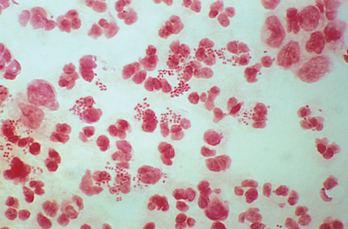CASE 29
LABORATORY STUDIES
Diagnostic Work-Up
A clinical diagnosis of urethritis was suspected.Table 29-1 lists the likely causes of the illness (differential diagnosis). Investigational approach may include
TABLE 29-1 Differential Diagnosis and Rationale for Inclusion (consideration)
Rationale: Urethral discharge in men is related to a relatively few organisms. In sexually active individuals, purulent discharge is highly suggestive of gonorrhea. The other agents in the differential diagnosis, particularly Chlamydia, generally cause a clear discharge.
MICROBIOLOGIC PROPERTIES
All Neisseria species (pathogenic or nonpathogenic) are Gram-negative diplococci. A smear of urethral discharge can be examined under a microscope after Gram staining. The presence of multiple pairs of bean-shaped, Gram-negative diplococci within a neutrophil in a Gram smear of urethral discharge (Fig. 29-1) is diagnostic of gonorrhea (more sensitive in males versus females). The organisms have a typical Gram-negative bacterial cell wall with a peptidoglycan backbone. The genus Neisseria contains two pathogenic species, N. gonorrhoeae (also known as gonococcus) and Neisseria meningitidis (also known as meningococcus). N. gonorrhoeae do not have a polysaccharide capsule but have pili, cell-wall lipo-oligosaccharide (LOS), and outer membrane proteins (OMP), all of which contribute to virulence. The fastidious organisms grow on selective media (e.g., Thayer Martin medium), supplemented with antimicrobial agents that inhibit competing flora while allowing growth of N. gonorrhoeae. All Neisseria are oxidase positive. N. gonorrhoeae isolates from clinical specimens are confirmed by sugar (glucose) fermentation, immunoassay, or DNA probes.
Stay updated, free articles. Join our Telegram channel

Full access? Get Clinical Tree



